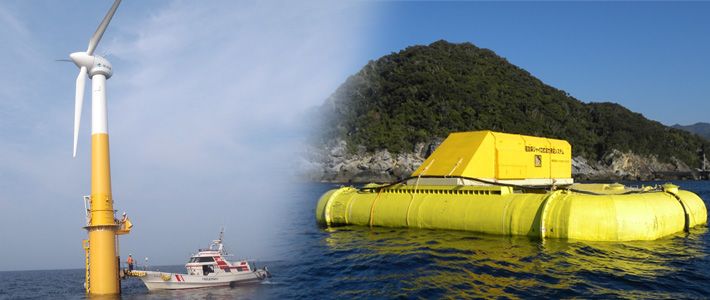
Energy Policy: Japan at the Crossroads
The Potential of Marine Energy
Science Technology- English
- 日本語
- 简体字
- 繁體字
- Français
- Español
- العربية
- Русский
Japanese Research Falls Behind
Spurred by the 1973 oil crisis, Japan led the global field in research and development of marine energy until 1998. As memory of the second oil shock, later in the 1970s, faded, the number of countries actively developing marine energy decreased, and the Japan Agency for Marine-Earth Science and Technology (JAMSTEC) ended its testing following the deployment of the Mighty Whale—an offshore, floating system in Mie Prefecture’s Gokasho Bay that doubled as a breakwater while efficiently generating electricity from wave power—after its efforts failed to reduce electricity generation costs below ¥140/kWh.
Britain, Portugal, and Norway continued their research and development of similar systems, though. As shown in Figure 1, this work successfully increased energy output from both wave and marine wind systems by 10 times over the subsequent decade. As Japan stood still, foreign countries steadily progressed, developing functioning systems like the SeaGen tidal generator, the Pelamis wave-energy generator, and the Hywind, an offshore, floating wind turbine that is poised to become a driving force in renewable energy. Unfortunately, at this point, Japan is as much as three generations behind.
The reasons for this are several. First, European advances in this field have been propelled by increasingly dire global warming predictions accompanied by the introduction of fossil fuel restrictions. Second, Europe has naturally gravitated toward marine energy—not only over security concerns as peak North Sea petroleum production approaches, but also due to the expectations for job creation in the nascent field. Another contributing factor is the application of numerous technological developments stemming from deep-water petroleum production in the rough, northern seas.
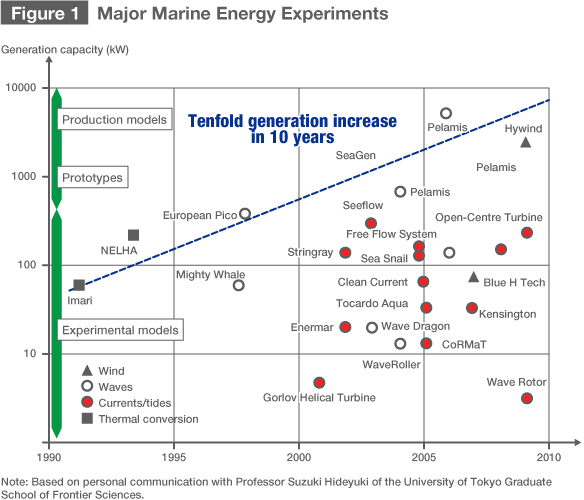
Energy Scenarios for the Future
Energy researchers have made a number of predictions for the global energy picture in 2050. As one middle-of-the-road outlook, University of Toronto Professor Danny Harvey provides the following projections for power generation in his 2010 book Carbon-Free Energy Supply.
- 6,000 GW–12,000 GW from wind generation
- 6,000 GW–12,000 GW from concentrated solar-thermal power
- 3,000 GW–4,000 GW from either standard or building-integrated photovoltaics
- A small amount from geothermal and biomass, as well as an increase in hydroelectric
- Direct high-voltage transmission between areas of principal renewable energy production and consumption
- Decommissioning of all existing nuclear reactors beyond their set 40-year lifespan
According to Harvey, all of the above appear reasonably attainable. Much of the wind generation is likely to be from offshore turbines. One aspect that Harvey does not touch on is that the construction and maintenance costs of wave and tidal systems will be drastically reduced by the expansion of these turbines.
On a global scale, the primary renewables will likely be wind and solar-thermal power. Generation from solar photovoltaics will probably provide around half the power produced by either of those two sources, and geothermal and biomass energy will make smaller contributions. Marine energy, in the forms of wave, tidal, and thermal conversion, would only account for a minor fraction of production. However, considering the high costs of transoceanic cabling—and, as discussed below, the obstacle of network impedance, or loss of energy during transmission—attention should also be focused on local energy grids, where the economic feasibility of marine energy sources will give them an important, small- to medium-scale role.
In Japan, the cost of marine energy should be comparable to that of other domestic renewables by around 2020 (Table 1), assuming favorable results following the completion of testing.
Table 1. Energy Economics
(Generation cost, ¥/kWh)
| 2012 | 2015 | 2020 | 2030 | |
|---|---|---|---|---|
| Solar photovoltaic | 26~40 | 23 | 14 | 7 |
| Terrestrial wind | 9~15 | 7~11 | 5~8 | |
| Marine wind | 9~15 | 12~17 | 8~11 | |
| Solar thermal | 13~30 | 10~15 | 5~17 | |
| Wave power | 30~50 | Approx. 40 | Approx. 20 | 5~10 |
| Ocean thermal conversion | 40~60 | 15~25 | 8~13 |
Source: NEDO Renewable Energy Technology White Paper, 2010.
In Japan’s near future, the practical marine energy options are limited to areas within 30 km of shore and within a maximum water depth of 100 m. Given these limitations, the maximum production potential is listed in Tables 2 and 3. The United States and Europe are already targeting depths in excess of 100 m. Japan needs to do the same: this would increase the maximum by more than an order of magnitude, making available a vast energy resource in the surrounding waters. Consideration must be given, however, to the fact that the task of catching up to the West is made more difficult by the high cost of domestic labor. As with other forms of renewable energy, it is essential that Japan develop competitive marine energy generation technology, but in doing so, it is imperative to carefully select and strategically develop an appropriate area of focus from among the various energy forms and associated technologies.
Table 2. Marine Energy Potential
(TWh/year)
| Marine wind | Wave | Thermal conversion | Oceanic current | Tidal current | Vertical tidal movement | ||
|---|---|---|---|---|---|---|---|
| Maximum possible energy generation | Current | 524 | 19 | 47 | 10 | 6 | 0.38 |
| Near future | 723 | 87 | 156 | 10 | 6 | 0.38 | |
| Nuclear equivalent (reactors) | 118 |
Notes: Generation potential within 30 km of shore and 100 m water depth. Data from the New Energy and Industrial Technology Development Organization (NEDO).
Table 3. Maximum Generation Potential
(MWh/Year)
| Regional power company | Wave power (current) | Wave power (future) | Thermal conversion (current) | Thermal conversion (future) |
|---|---|---|---|---|
| Hokkaidō | 0 | 7,236,461 | 0 | 244,404 |
| Tōhoku | 0 | 15,651,842 | 0 | 13,339,728 |
| Tokyo | 10,696,748 | 25,897,889 | 19,268,496 | 53,658,504 |
| Hokuriku | 0 | 6,731,359 | 0 | 5,077,296 |
| Chūbu | 0 | 0 | 0 | 5,234,976 |
| Kansai | 0 | 1,910,293 | 654,372 | 3,894,696 |
| Chūgoku | 0 | 133,240 | 0 | 4,446,576 |
| Shikoku | 0 | 0 | 504,576 | 4,706,748 |
| Kyūshū | 0 | 9,295,762 | 4,446,576 | 29,588,652 |
| Okinawa | 8,175,971 | 20,302,351 | 22,051,548 | 35,651,448 |
| Total | 18,872,719 | 87,159,197 | 46,925,568 | 155,843,028 |
| Nuclear equivalent (reactors) | 3.6 | 17 | 8.9 | 30 |
Note: Data from the New Energy and Industrial Technology Development Organization (NEDO).
The Need for New Transmission Systems
As I explain above, while Japan is surrounded by vast, untapped marine energy resources, domestic research and development is as much as three generations behind that of the West. This deficiency is not limited to marine energy: it extends to other renewables as well. For example, hydroelectric excluded, in some European and North American countries, renewables already account for about 10% of the energy supply, a ratio more than 10 times greater than in Japan.
The first problem is Japan’s power transmission system. Shifting to reliance on natural power sources on a wide scale requires that steps be taken in the following three stages.
Stage 1: As is done in Europe, establish low-percentage renewable energy targets and begin forecasting daily supply and demand, allowing for adjustments as needed. Strengthen connecting infrastructure between regional power companies.
Stage 2: Concurrently with preparations for Stage 3, construct “smart grids” that account for local characteristics to allow adjustment in distribution of up to 30% of the total generated supply. This may be accomplished by a variety of methods, such as batteries or pumped-storage hydroelectric generation, which uses surplus power to pump water to higher elevations, where it is stored until needed and released through turbines, generating electricity.
Stage 3: Roll out next-generation transmission control technology to enable renewables to provide 40%–50% of the nation’s total needs. This involves a major rethinking of the present system to overcome the challenge of network impedance—the loss of power when it is transmitted over long distances—by creating local grids throughout the nation, facilitating the local generation and local consumption of power. Pumped-storage hydroelectric facilities including large-scale storage cells are installed to fill gaps in supply that occur when generation facilities go offline unexpectedly, and network switching systems are put in place to cope with peaks in load.
Japan will likely have this type of grid in place by 2050—indeed, it must have it. If not, energy demand will be constrained by the old grid, resulting in rolling blackouts when supply falls short and dealing a blow to the economy. On the other hand, if the proper innovations are made to the power grid, with a focus on local production and consumption of renewable energy, individual regions should prosper. The independent implementation of small-scale marine solutions, rather than large-scale wind farms, will be an important part of effectively meeting local power demand.
Securing Sites for Demonstrations and Testing
One of the reasons for Japan’s large lag behind the United States and Europe is the nation’s lack of defined testing areas. Actual deployment at sea is essential to determining the durability of a planned facility and estimating the cost of installation, operation, and repairs, but the financial and labor costs of this are enormous. A significant proportion of these costs are incurred in securing usage rights from the area’s stakeholders. Furthermore, the procedures of applying to use a marine location are complicated, including many steps. Data monitoring equipment and cables are limited to a single usage and represent a significant, recurring cost. And once testing is complete, more funds and labor are required for facility removal.
To reduce the burden on researchers, European nations began establishing dedicated testing areas over a decade ago, and more than 10 are currently in place. Japan has finally begun formulating plans for the creation of dedicated marine energy testing and demonstration sites. These areas are expected to be instrumental to the consistent production of high-quality, low-cost, competitive generation devices.
Japan’s lack of research and development progress is related to the difficulty of reaching agreements on the usage of testing sites. These sites interfere with navigation lanes and fishing grounds, impacting the interests of the displaced individuals and corporations in complex ways. With the beginning of marine wind power generation in Europe during the late 1990s, reasonable solutions to these problems were found in multinational frameworks relying on marine spatial planning and integrated ocean management techniques. These are now widely used management standards that provide adaptively measured, multilayered information on such parameters as environment, fisheries, and navigation.
The Japanese Coast Guard has created CeisNet, a Web-based geographic information system, or “marine ledger,” that aims to increase regional understanding by displaying coastal information. This tool is expected to speed up the process of reaching reasonable usage agreements. The following elements will be important to selecting areas to develop marine energy sources:
- Power generation potential
- Water depth, sediment type, wave climate, prevailing winds, and tidal currents
- Fisheries information (rights holders, fishing techniques in use)
Knowledge of the following two additional points will have a large effect.
- The locally active fishing guild’s financial situation and history of internal conflicts
- Local fishers’ entrepreneurial disposition
Electric power generation by fishing guilds is currently prohibited under the broader marine commercial regulations. However, if these groups are permitted to generate electricity, this could power innovation in hatcheries, terrestrial and offshore aquaculture, and electric propulsion of fishing vessels, as well as benefitting the groups’ areas through the local production and consumption of energy.
Renewables to Foster Civic Pride
Japan’s current electric power laws, enacted in 1947, earmark a portion of the fees collected from electricity bills as subsidies to be paid to municipalities that host power generation facilities. As a relatively simple tool for spreading economic benefits throughout the country, they had some effect, but their impact on deeper-reaching regional development has been undeniably limited. Renewable energy offers something different: communities that choose to host such facilities are making a voluntary choice to live in balance with nature, which should be a source of pride to local residents and a way for them to signal their desire to move to a future of more ethical values.
With the decline of the heavy and chemical industries, once an engine of rapid economic growth, in the United States and Europe, there were a number of renewable energy trials and attempts at creating “smart cities.” Many were failures, unfortunately, but the efforts that succeeded all sparked a sense of pride among the local residents.
On March 31, 1998, the cabinet approved the Grand Design for the Twenty-first Century, which among other things created a comprehensive coastal management council to guide planning and promote development in Japan’s coastal regions. Headed by members of the national bureaucracy, this council included direct stakeholders in coastal issues, as well as local residents and representatives of businesses, fisheries, and nonprofit organizations. The goal was to engage as many actors as possible in the decision-making to ensure those decisions would be all the more effective. Unfortunately, the cabinet decision to launch this group never gained the force of law, making it difficult to call the exercise effective at all, in the end. In response to hopes from those involved in marine energy research for an end to this inaction, the government launched its Headquarters for Ocean Policy (led by the prime minister, with related ministers as members) on May 25, 2012. The goal of this endeavor is to develop and commercialize Japan’s marine renewable energy potential by preparing dedicated demonstration sites for large-scale testing.
Ongoing Projects
Japan is now engaged in a number of projects aimed at developing marine energy resources. Here I describe a few of them.
In the Gotō Islands of Nagasaki Prefecture, the Ministry of the Environment is testing a floating marine wind turbine from 2011 to 2015. This 2 MW offshore project has demonstrated favorable results with respect to weather and sea conditions, safety design and evaluation, and maintenance. This is the world's third test of a floating turbine, and the ministry is carrying out detailed environmental impact studies to facilitate future local cooperation.
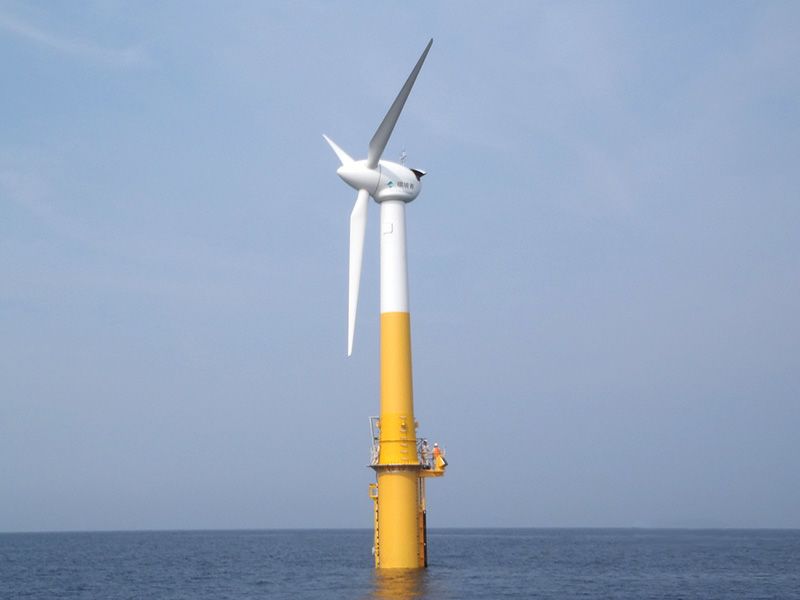 The floating turbine offshore of the Gotō Islands. (Courtesy: Ministry of the Environment)
The floating turbine offshore of the Gotō Islands. (Courtesy: Ministry of the Environment)
Also from 2011 to 2015, the New Energy and Industrial Technology Development Organization (NEDO) is testing four types of ocean wave and tidal energy generators, and two innovative types of current and thermal generators are also in development.
Figure 2 depicts a buoy to generate power from waves; it is designed to be pulled underwater during a typhoon in order to avoid storm waves with excessive energy. Figure 3 shows an OWC, or oscillating water column, wave power generator designed to collect wave energy more efficiently via projected walls extending from the side of the levee. In Figure 4 we see a wave power generator that uses a domestically developed gyro-equipped power takeoff device. Figure 5 shows proposed tidal current generators whose modular design simplifies maintenance, an especially important task from the economic perspective. These four types are currently being tested.
The projects still in the development phase, meanwhile, are a moored fin current generator for deployment in the Pacific Kuroshio Current (Figure 6), and a high-efficiency ocean thermal energy converter (Figure 7).
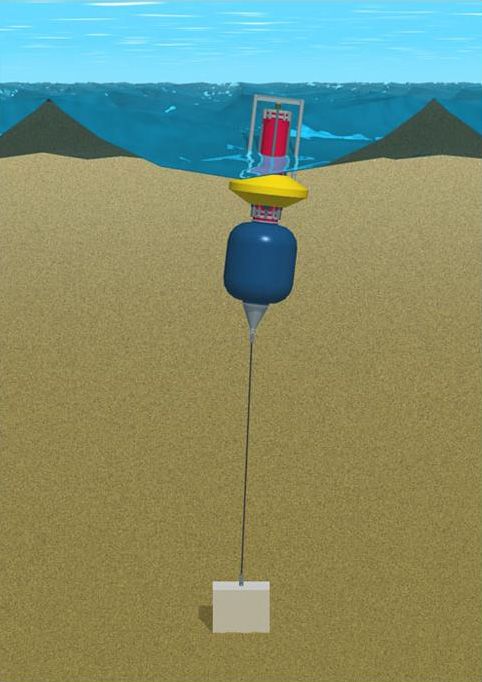 Figure 2. This buoy generates power from waves while remaining able to withstand a typhoon. (Courtesy: Mitsui Engineering & Shipbuilding)
Figure 2. This buoy generates power from waves while remaining able to withstand a typhoon. (Courtesy: Mitsui Engineering & Shipbuilding)
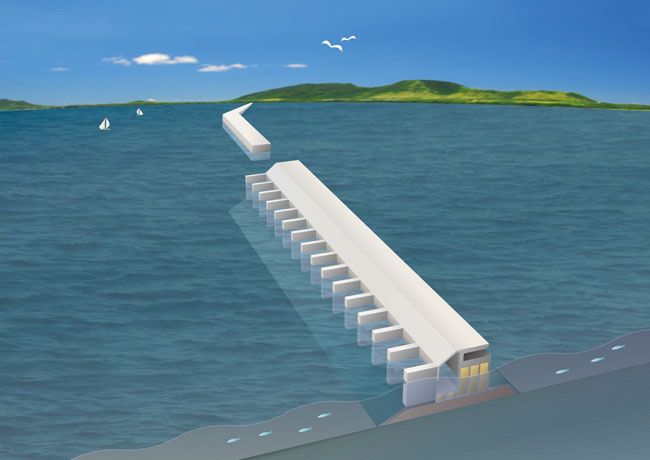 Figure 3. The projected walls channel waves more efficiently to the OWC generators along the levee. (Courtesy: JAMSTEC)
Figure 3. The projected walls channel waves more efficiently to the OWC generators along the levee. (Courtesy: JAMSTEC)
 Figure 4. This gyro-equipped wave power generator makes use of Japanese developed technology. (Courtesy: Gyrodynamics)
Figure 4. This gyro-equipped wave power generator makes use of Japanese developed technology. (Courtesy: Gyrodynamics)
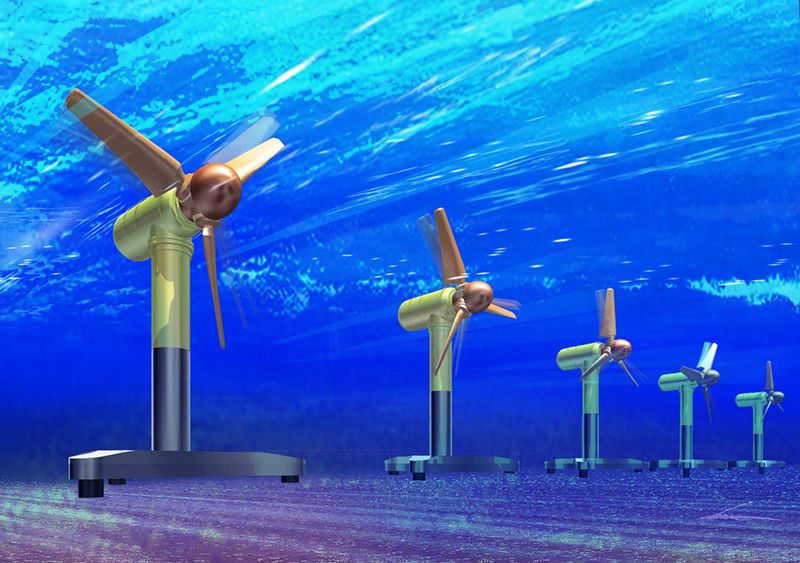 Figure 5. Installed on the ocean floor, this tidal current generator features modular design for ease of maintenance. (Courtesy: Kawasaki Heavy Industries)
Figure 5. Installed on the ocean floor, this tidal current generator features modular design for ease of maintenance. (Courtesy: Kawasaki Heavy Industries)
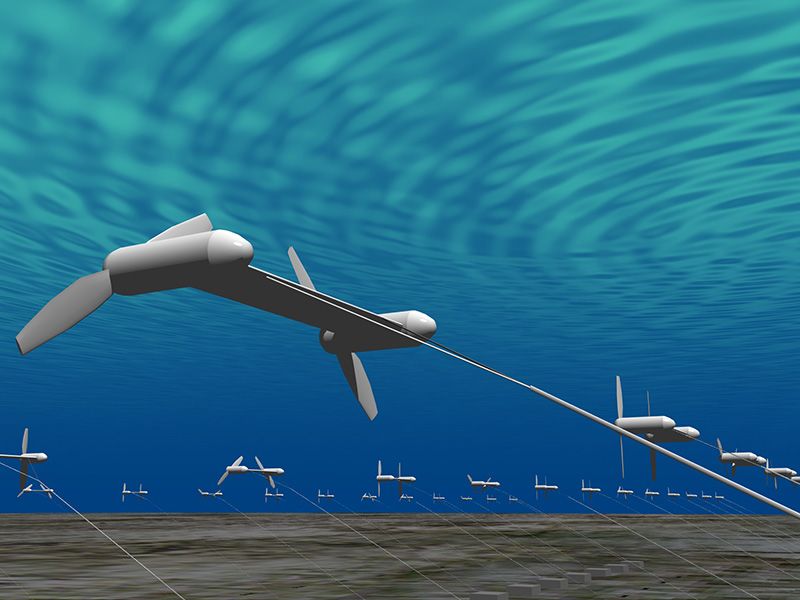 Figure 6. These moored Kuroshio current generators are being jointly developed by IHI, Toshiba, the University of Tokyo, and the Mitsui Global Strategic Studies Institute. (Courtesy: IHI Corporation)
Figure 6. These moored Kuroshio current generators are being jointly developed by IHI, Toshiba, the University of Tokyo, and the Mitsui Global Strategic Studies Institute. (Courtesy: IHI Corporation)
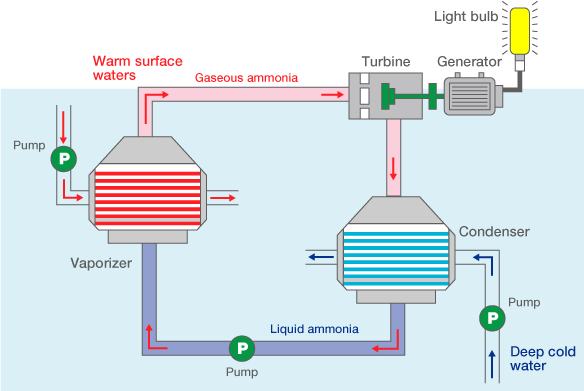 Figure 7. A planned ocean thermal conversion generator using highly efficient heat exchangers. (Source: Institute of Ocean Energy, Saga University)
Figure 7. A planned ocean thermal conversion generator using highly efficient heat exchangers. (Source: Institute of Ocean Energy, Saga University)
Finally, another project planned for 2012 to 2016 aims to develop clean marine energy as a means of reconstructing the Tōhoku region, which was battered by the March 2011 disaster. This system uses a ship’s rudder and control system in reverse, harnessing wave power for electrical generation by driving a generator as the rudder’s direction is changed. This will be built and assembled in local shipyards in Tōhoku, and power generation and consumption will also be local, thus promoting regional advancement.
Technology for Future Growth
In Japan, decreasing the cost of marine energy is especially important. The cost of power transmission in general, and in particular that using submarine cabling, is extremely high. However, with the exception of certain parts of the northern island of Hokkaidō and the Tōhoku region of northern Honshū, near-shore installations actually offer lower transmission costs and have less environmental impact than wind turbines constructed in mountainous areas. Moreover, going offshore makes it possible to minimize problems associated with transportation of large turbines, such as road-related obstacles, allowing for large-scale installation at further reduced cost.
Upscaling of near-coastal wind farms should begin immediately, and we must waste no time in solving the potential technological problems associated with development of the offshore installations that are needed to make Japan an internationally competitive player in marine renewables. It cannot be emphasized enough that cost reduction of floating power generators is essential. This requires integrated development of construction platforms and methodologies. Combining tidal and wave power generation capacities into a single platform presents a great potential cost reduction. Finally, Japan must develop a comprehensive plan to optimize marine energy production, addressing issues in areas including energy storage and fisheries facilities.
nuclear University of Tokyo renewable energy thermal solar wind biomass CeisNet current Danny Harvey geothermal Institute of Industrial Science JAMSTEC Japan Agency for Marine-Earth Science and Technology Japan Ocean Energy Association Kinoshita Takeshi marine energy Mighty Whale Ministry of the Environment NEDO New Energy and Industrial Technology Development Organization oil crisis photovoltaic smart grids tidal wave